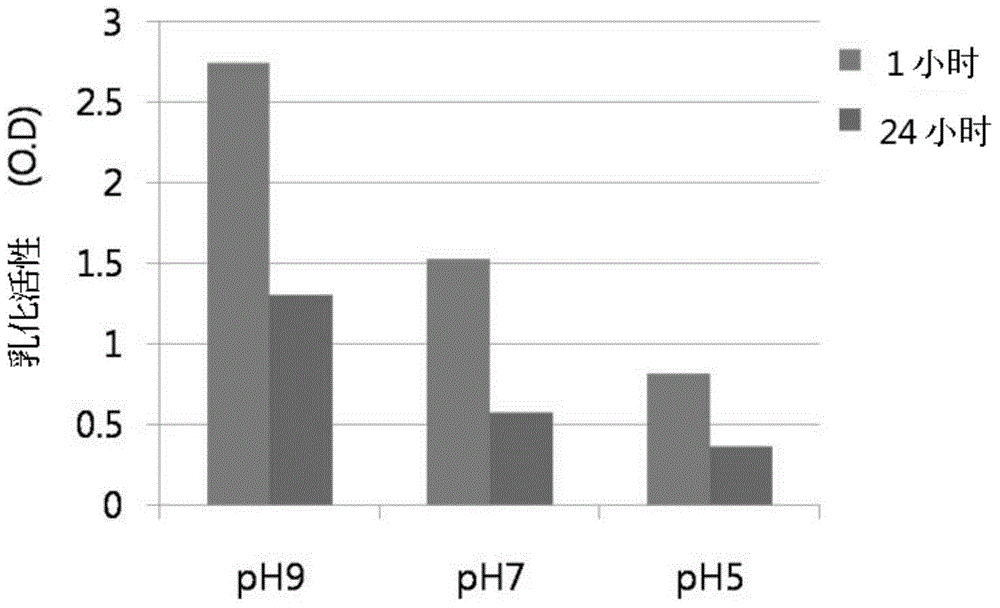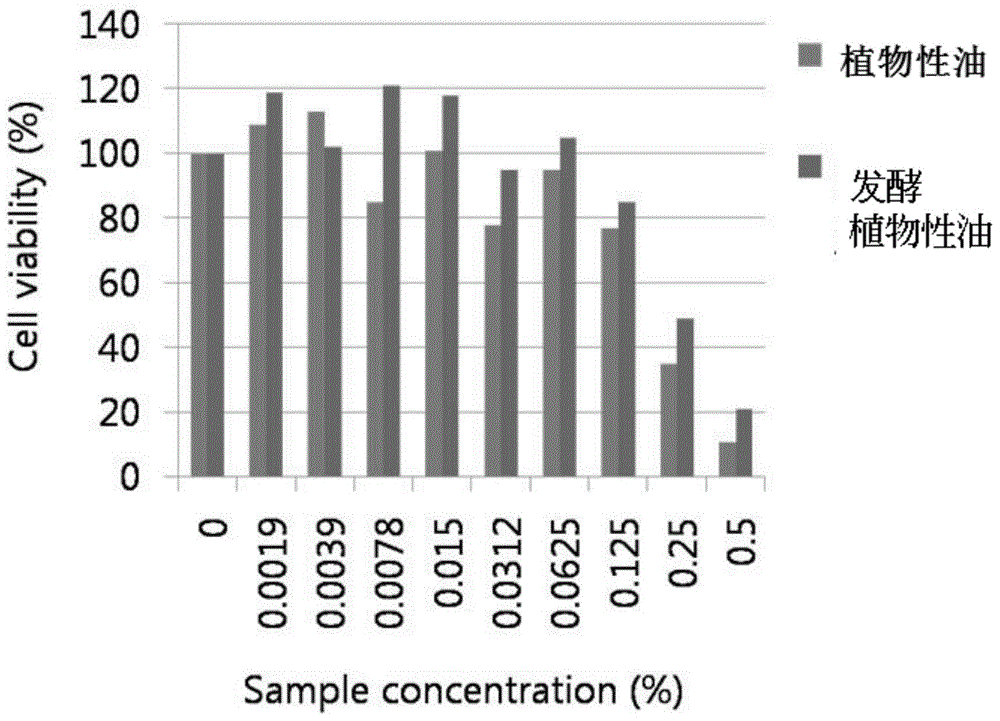Fermented vegetable grease cosmetic composition having antioxidant effect
A cosmetic composition and anti-oxidation technology, which is applied in the direction of fat-rich agent washing composition, cosmetics, cosmetics, etc., can solve the problems of weak technology and achieve the effect of improving emulsifying activity
- Summary
- Abstract
- Description
- Claims
- Application Information
AI Technical Summary
Problems solved by technology
Method used
Image
Examples
Embodiment 1
[0063] Embodiment 1: Utilize microorganism to prepare fermented oil
[0064] 1) First fermentation
[0065] 1L of culture solution (glucose 10g / L, olive oil 100g / L, yeastextract 3g / L, malt extract 3g / L, peptone 3g / L, 3g / L of soybean meal (soya bean meal), 2g / L of (NH4 2 SO 4 , 1g / L of KH 2 PO 4 , 0.5g / L of MgSO 4 , 0.1g / L of CaCl 2 , 0.1 g / L of NaCl: the medium of the above composition 4) was inoculated with Basidiomycetes SY16 [KCTC 8950P], and cultured at a temperature of 25° C., 300 rpm, and aerobic conditions.
[0066] After culturing, take 1ml of culture solution at each time period (3, 7, 12, 24, 48, 72, 96h), and use a spectrophotometer to measure the growth rate of microorganisms and the activity of lipase at 660nm . As a result of measuring lipase activity, it was confirmed that the first fermentation time with the highest lipase activity was 48 hours.
[0067] 2) Second fermentation and production of fermented oil
[0068] Basidiomycetes SY16 [KCTC8950P] ...
experiment example 1
[0077] Experimental example 1: Evaluation of antioxidant capacity
[0078] Utilize 1,1-diphenyl-2-trinitrophenylhydrazine (DPPH,1,1-diphenyl 1-2-picry1hydrazy1) method and test the oil of embodiment 1 together with the oil of comparative example 1 to comparative example 4 Antioxidant energy. Evaluation of Antioxidant Ability To measure free radical scavenging activity, 1,1-diphenyl-2-trinitrophenylhydrazine (1,1-diphenyl 1-2-picry1hydrazyl) was used. That is, to 2.4mL of 4.0×10-4M 1,1-diphenyl-2-trinitrophenylhydrazine solution, add 0.6mL of the oils of Example 1, Reference Example 1 to Reference Example 4, respectively, and mix by vortexing The shaker was shaken for 10 seconds, and left at room temperature for 30 minutes. Then, the absorbance was measured at 517 nm, and the antioxidant activity was expressed as the decrease ratio of the absorbance relative to the control group. In this case, ascorbic acid (ascorbic acid), which is an antioxidant, was used as a comparison gr...
experiment example 2
[0082] Experimental Example 2: Evaluation of Hydroxyl Radical Elimination Ability
[0083] In this Experimental Example 6, in order to measure the antioxidant activity of the above-mentioned examples, the elimination energy of hydroxyl radicals was measured. In 3mL of 0.02M phosphate buffer (Potassiumphosphate buffer) (pH7.0), sequentially add 0.5mL of linoleic acid (Linoleic acid) for the matrix, 0.5mL of each diluted sample, 0.5mL 0.1mM FeSO 4 ·7H 2 O, 0.5 mL of 100 mM H 2 o 2 , to mix evenly, and react at a temperature of 37° C. for 1 hour. In this case, the control group reacted using distilled water instead of adding the sample. After the reaction finished, add 1mL of 2.8% sodium trichloroacetate (TCA, Trichloroacetic acid) and 1mL of 1% thiobarbituric acid (TBA, Thiobarbituric acid) respectively in the above-mentioned reaction liquid, and boiled water at 100 ℃ temperature React for 10 minutes. After the reaction solution was cooled, it was centrifuged at 2000 rp...
PUM
 Login to View More
Login to View More Abstract
Description
Claims
Application Information
 Login to View More
Login to View More - R&D
- Intellectual Property
- Life Sciences
- Materials
- Tech Scout
- Unparalleled Data Quality
- Higher Quality Content
- 60% Fewer Hallucinations
Browse by: Latest US Patents, China's latest patents, Technical Efficacy Thesaurus, Application Domain, Technology Topic, Popular Technical Reports.
© 2025 PatSnap. All rights reserved.Legal|Privacy policy|Modern Slavery Act Transparency Statement|Sitemap|About US| Contact US: help@patsnap.com



